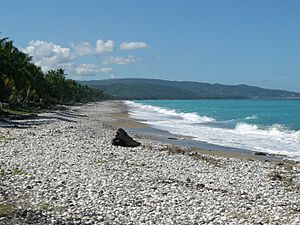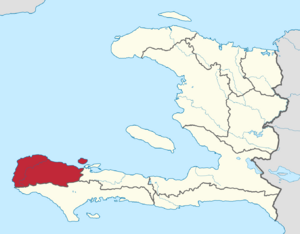Grand'Anse Department facts for kids
Quick facts for kids
Grand'Anse
Grandans
|
|
|---|---|

Gommier, Haiti
|
|

Grand'Anse in Haiti
|
|
| Country | |
| Capital | Jérémie |
| Région | Tiburon Peninsula |
| Symbole | Lanbi-conch enclosed in mountain range |
| Area | |
| • Total | 1,911.97 km2 (738.22 sq mi) |
| Population
(2015)
|
|
| • Total | 468,301 |
| • Density | 244.9311/km2 (634.3688/sq mi) |
| HDI (2017) | 0.454 low · 9th |
Grand'Anse, also known as Grandans or Grantans, means "Big Cove." It is one of the ten departments of Haiti. Its capital city is Jérémie.
Contents
History of Grand'Anse
Early History: Taino People
Long ago, Grand'Anse was part of the Xaragua kasika. This was a large area ruled by the Taino people. There were many Taino settlements here, like Mamey. Today, the town of Abricot is still called "the Indian's Paradise." This shows its deep roots with the Taino culture.
French Rule and Education
Locals say that Jérémie, the capital city, got its name from a French fisherman. He settled there because the area was quite isolated. Grand'Anse has many mountains, so it did not have many large farms. Because of this, there were communities of white and mixed-race people. They had some of the best schools in the colony. Some wealthy families even sent their children to schools in Grand'Anse. This was instead of sending them all the way back to France for their education.
Brief British Control
For a short time in 1793, the department was under British control.
Haiti's Independence Journey
The Haitian Revolution in Grand'Anse
During the Haitian Revolution, Grand'Anse played a key role. While André Rigaud was in charge, many enslaved people died in prison in Jérémie. The exact reason for their deaths was not clear. However, Toussaint Louverture used this event. He wanted to show Rigaud as being against Black people. Louverture then ordered his officer, Jean-Jacques Dessalines, to attack Jérémie.
This battle was very important in the Haitian Revolution. An officer named Laurent Férou became known as the "Liberator of the Grand'Anse." Grand'Anse was the first department to be taken by the Armée Indigène (the native army). They captured it from French troops on August 4, 1803.
After Independence: A New Nation
Laurent Férou was one of the people who signed Haiti's Act of Independence on January 1, 1804. After Haiti became independent, the country faced its first civil war. The nation was split into two parts: a monarchy in the north and a republic in the south.
Grand'Anse mostly supported the monarchy. This was under the leadership of Jean-Baptiste Perrier, also known as Goman. He set up a government in the Macaya mountains. This was called the Kongo Kingdom.
Fort Marfranc was built to protect Jérémie. It was ordered by Dessalines. Férou, the "Liberator," is buried there. The Kongo Kingdom in Grand-Doco lasted for 20 years. It was supported by Henri Christophe, who was the self-declared king of the northern monarchy. Goman was given the title of duke. Later, the department came under the control of the republic. This happened under the leadership of Jean-Pierre Boyer.
Many battles between different political groups happened in Grand'Anse during the 1800s.
Grand'Anse in Modern Times
The Grand'Anse department used to be part of the Sud department. It became its own department in 1962. In 2003, it became even smaller. A new department called Nippes was created from some of its areas. Before this split in 2003, Grand'Anse had about 600,000 people. After the split, its population was around 337,516 in 2003. The department now covers about 1,912 square kilometers (738 sq mi).
Geography and Environment
Grand'Anse is located on the western side of Haiti. To the north, it borders the Gulf of Gonave. To the west, it faces the Windward Passage, which connects to Jamaica. The South Department is to its south, and the Nippes Department is to its east.
Even though it is one of Haiti's smaller departments, Grand'Anse is known for being very clean. This is partly because it is quite isolated. The westernmost point in Haiti, Cap les Irois, is found here.
The Macaya mountain chain is part of the Massif de la Hotte. It holds Haiti's second-highest mountain. This area is a very important nature reserve. It is home to many animals and plants found nowhere else in the world. The Plaintain Garden-Enriquillo fault line also runs through it. Because of all the mountains, Grand'Anse does not have large flat areas for farming. However, the Jeremi Valley is still a major farming area.
Important rivers in the department include the Grand'Anse and Voldrogue rivers. Grand'Anse also has many islands. These include Grande Cayemite, Petite Cayemite, and the Cayemite reefs. Navassa Island is also nearby. Navassa is currently claimed by both Haiti and the United States. The U.S. manages it through the US Fish and Wildlife Service.
Transportation
Grand'Anse is one of the most isolated departments in Haiti. Jérémie has the largest port. This port is mainly used for cabotage, which means shipping goods between ports within the same country. The Jérémie airport can handle flights from Port-au-Prince.
The RN7 is part of Haiti's national road system. It connects Jérémie to Les Cayes. There are also plans for a road to connect Grand'Anse to Nippes.
Economy
Grand'Anse has great potential for its economy. It could grow a lot in the agro-industry, which means making products from farm goods. The tourism sector also has a lot of promise. This includes fun leisure tourism, eco-tourism (visiting nature), and historical and cultural tourism.
The most famous beaches in the department are Anse d'Azur and Anse du Clerc.
Culture
The people of Grand'Anse are known for being very welcoming. They are also famous for their cooking skills. Their most well-known dish is Tonmtonm-Kalalou. This Haitian dish is similar to West African Fufu. Many farmers in Grand'Anse use a pipirit. This is a Haitian bamboo raft. They use it to carry their crops to market towns.
Administrative Divisions
The Department of Grand'Anse is divided into three main areas called arrondissements. These arrondissements are then further divided into smaller areas called communes. There are thirteen communes in total.
- Arrondissement of Anse d'Hainault
- Anse-d'Hainault
- Dame-Marie
- Les Irois
- Arrondissement of Corail
- Corail
- Beaumont
- Pestel
- Roseaux
- Arrondissement of Jérémie
- Jérémie
- Abricots
- Bonbon
- Chambellan
- Moron
- Marfranc
See also
 In Spanish: Departamento Grand'Anse para niños
In Spanish: Departamento Grand'Anse para niños


